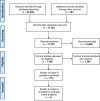Clinical effectiveness of manual therapy for the management of musculoskeletal and non-musculoskeletal conditions: systematic review and update of UK evidence report
- PMID: 24679336
- PMCID: PMC3997823
- DOI: 10.1186/2045-709X-22-12
Clinical effectiveness of manual therapy for the management of musculoskeletal and non-musculoskeletal conditions: systematic review and update of UK evidence report
Abstract
Background: This systematic review updated and extended the "UK evidence report" by Bronfort et al. (Chiropr Osteopath 18:3, 2010) with respect to conditions/interventions that received an 'inconclusive' or 'negative' evidence rating or were not covered in the report.
Methods: A literature search of more than 10 general medical and specialised databases was conducted in August 2011 and updated in March 2013. Systematic reviews, primary comparative studies and qualitative studies of patients with musculoskeletal or non-musculoskeletal conditions treated with manual therapy and reporting clinical outcomes were included. Study quality was assessed using standardised instruments, studies were summarised, and the results were compared against the evidence ratings of Bronfort. These were either confirmed, updated, or new categories not assessed by Bronfort were added.
Results: 25,539 records were found; 178 new and additional studies were identified, of which 72 were systematic reviews, 96 were randomised controlled trials, and 10 were non-randomised primary studies. Most 'inconclusive' or 'moderate' evidence ratings of the UK evidence report were confirmed. Evidence ratings changed in a positive direction from inconclusive to moderate evidence ratings in only three cases (manipulation/mobilisation [with exercise] for rotator cuff disorder; spinal mobilisation for cervicogenic headache; and mobilisation for miscellaneous headache). In addition, evidence was identified on a large number of non-musculoskeletal conditions not previously considered; most of this evidence was rated as inconclusive.
Conclusions: Overall, there was limited high quality evidence for the effectiveness of manual therapy. Most reviewed evidence was of low to moderate quality and inconsistent due to substantial methodological and clinical diversity. Areas requiring further research are highlighted.
References
-
- Hoving JL, Koes BW, de Vet HC, van der Windt DA, Assendelft WJ, Van MH, Deville WL, Pool JJ, Scholten RJ, Bouter LM. Manual therapy, physical therapy, or continued care by a general practitioner for patients with neck pain. A randomized, controlled trial. Ann Intern Med. 2002;136:713–722. doi: 10.7326/0003-4819-136-10-200205210-00006. - DOI - PubMed
-
- Farrell JP, Jensen GM. Manual therapy: a critical assessment of role in the profession of physical therapy. Phys Ther. 1992;72:843–852. - PubMed
-
- Fitzgerald GK, McClure PW, Beattie P, Riddle DL. Issues in determining treatment effectiveness of manual therapy. Phys Ther. 1994;74:227–233. - PubMed
-
- Jette AM, Delitto A. Physical therapy treatment choices for musculoskeletal impairments. Phys Ther. 1997;77:145–154. - PubMed
-
- Garofalo JP, Polatin P. In: Psychosocial factors in pain: Critical perspectives. Gatchel RJ, Turk DC, editor. New York: Guilford Press; 1999. Low back pain: an epidemic in industrialized countries; pp. 164–174.
Grants and funding
LinkOut - more resources
Full Text Sources
Other Literature Sources
Medical
Molecular Biology Databases


